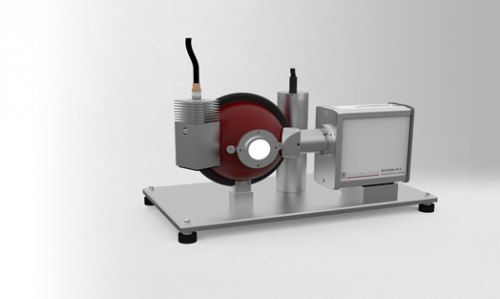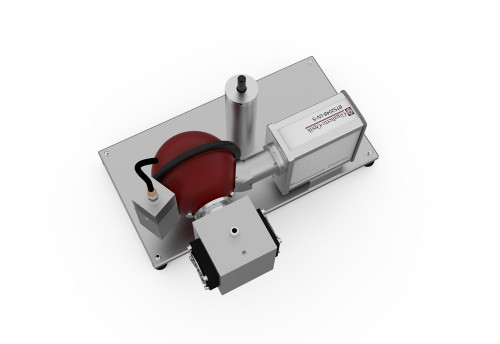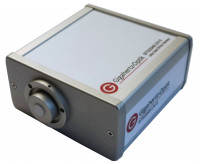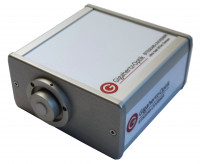This product is no longer manufactured. Remaining stock may still be available. Please refer to the alternatives listed below under "Similar products" or contact us directly.
Alternative Products for this discontinued product:
TFUV10
Spectroradiometer for Total Radiant Power Measurements of UV LEDs from 200 nm to 550 nm
- Lowest Stray Light Spectroradiometer
- 100 mm fluorescence-free integrating sphere, auxiliary lamp and long-term fluorescence reduction lamp
- Barium sulfate or ODM, as you like, we offer both. Both have advantages and disadvantages.
- Optional calibration standard for system recalibration by the user

Peculiarity when measuring UVC LEDs
Ultraviolet optical radiation (UV radiation) is used in a variety of tasks. It can be used to modify the physical properties of materials - radiation curing - or to treat skin diseases such as psoriasis. Water, air and solid surfaces are disinfected with UV radiation. A wide variety of gases and biomolecules can be detected with UV radiation. Among artificial radiation sources of UV radiation, UV LEDs are becoming a serious alternative to the hitherto dominant gas discharge lamps. Although the technology of UV LEDs is still young, it is making fast progress particularly in the UVB and UVC spectral ranges. The classic instrument for measuring the total radiant power of UV LEDs is a spectroradiometer with an integrating sphere.
A peculiarity of quasi monochromatic LED radiation must be considered when designing integrating sphere spectroradiometers for UV LEDs. The monochromatic UV radiation of the LED causes fluorescence of the integrating sphere coating which leads to significant measurement errors that cannot be compensated by conventional correction methods. Research at the Gigahertz-Optik laboratory has confirmed that barium sulfate coatings and synthetic coatings for integrating spheres both fluoresce when exposed to UVC LEDs < 250 nm. This fluorescence is caused by organic molecules which deposit over time on the integrating sphere’s coating. When stimulated with UV-LED radiation <= 230 nm, the radiant flux of the fluorescence can even reach the magnitude of the radiant power of UV-LEDs themselves. The fluorescence level can be reduced by irradiating the organic molecules using a sufficient UV radiation dose. Thereby, the organic molecules are destroyed and the fluorescence is reduced to values below the metrological detection limit. However, this measure has no lasting effect since additional organic molecules accumulate over time.
See also our technical article Fluorescence-free radiant flux measurement of UV LEDs.
ODM or barium sulfate? The choice is yours, we offer both!
Further studies have also shown that barium sulfate coatings fluoresce less than synthetic coatings. In addition, the reduction in fluorescence in case of barium sulfate coatings has a longer lasting effect (see technical article). For this reason, contrary to the previous guidelines, barium sulfate is recommended as a coating material for short wavelength UV measurement applications when lowest fluorescence is needed. Due to the particularly low dose of binders in Gigahertz-Optik’s ODP97 barium sulfate coating, the topic of long-term stability under permanent UV irradiation is not so critical since barium sulfate itself is UV-stable. However, synthetic coatings still show more stable spectral reflective properties under deep UV irradiation. Thus, the choice of coating also depends on the application. If the focus is on stability, ODM would be preferred, if the focus is on no fluorescence, it would be barium sulfate. However, it should be mentioned that especially the TFUV10 measuring system is able to reduce the fluorescence on site by the user due to the included aging lamp, even in case of ODM, thus providing a very good universal measuring system.
With the TFUV10-V01, Gigahertz-Optik offers a UV spectroradiometer for measuring the absolute radiation power of UVA, UVB and UVC LEDs in the spectral range from 200 nm to 550 nm. The instrument offers all features and functions required for this application.
Integrating sphere for radiant flux measurement
The spectroradiometer’s entrance optic for total radiant flux measurement is a 100mm diameter integrating sphere with an input aperture of 25.4 mm diameter. A sturdy port frame allows attachment of LED assemblies or the optional 2-Pi calibration standard. This standard allows the in-situ recalibration of the system by the user. The auxiliary lamp is used to compensate for the self-absorption effects caused by devices under test. The sphere coating is pre-aged using UV radiation which increases the long-term stability of the barium sulfate or ODM coating (both available) towards UV radiation and reduces fluorescence effects to below the detection limit of the measuring device. For permanent suppression of fluorescence, a UV lamp is additionally present which effectively and permanently suppresses the excitation of the fluorescence by UVC radiation below 250 nm. Furthermore, there connections for air flow are available to reduce possible ozone generated in the sphere (by very deep UV radiation). Ozone would lead to a characteristic spectral absorption in the sphere.
High resolution spectroradiometer
The BTS2048-UV-2-F is part of the BTS2048 Series, which has proven itself in a wide variety of demanding applications ranging from high-speed LED binning to the measurement of outdoor solar radiation. Such applications require the highest precision as well as reliability for continuous use. The spectroradiometer, which is attached directly to the integrating sphere without using a light guide, offers a spectral range from 200 nm to 550 nm with a spectral resolution of 1 nm. Remote-controlled optical filters increase the dynamic range. The pixels of the temperature-stabilized CCD can be synchronously set to zero. This feature offers the possibility to measure single pulses within a pulse chain.
Stray light and dark signals
Stray light and dark level offsets have a significant influence on the measurement results of UV spectroradiometers employing CCD or CMOS array sensors.
- Stray light incorrectly illuminates pixels thereby producing measurement signals that do not result from the desired wavelength. If stray light is not suitably suppressed, it becomes impossible to separate the LED’s real spectrum from stray light effects. The BTS2048-UV-2-F spectroradiometers offer innovative stray light suppression through integrated light traps and optical filters.
- The influence of dark signals results from varying operating temperatures of the measuring instrument and adapted integration times for specific irradiance levels. The dark signal shutter of the BTS2048-UV-2-F spectroradiometer is used to measure the dark signal which is used for the dark signal correction of future measurements.
Data logger
The BTS2048-UV-2-F supports a high measurement repetition frequency due to its high sensitivity, powerful electronics and its fast interfaces (USB 2.0 and Ethernet). It also serves as a data logger for recording temporal signal changes.
A complete package
The TFUV10-V01 delivers a complete package for its intended use. The setting of the measuring parameters and evaluation of the measured data are fully supported by the included software. Furthermore, it allows the control of the system’s auxiliary lamp. It is also possible to use the software for system re-calibrations by the user if one of the optional calibration light sources available from Gigahertz-Optik is used.
Factory calibrations and ISO/IEC/EN 17025 testing measurements
The measurement laboratory of Gigahertz-Optik offers high quality and traceability of their TFUV10-V01 factory calibrations. Factory calibrations are handled in Gigahertz-Optik’s calibration laboratory using the same quality management procedure which applies to NMI accredited test measurements. NMI accredited testing measurements with an ISO/IEC/EN 17025 testing certificate are optionally available.

TFUV10-V01 during the measurement of BN-LDSF-2P.
Similar Products
Product Categories

